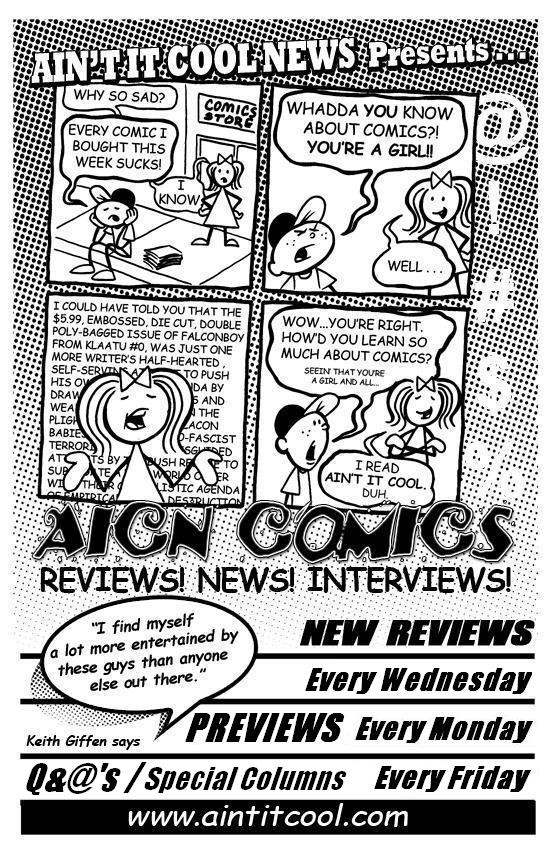
@@@@ What the #$%! is AICN COMICS: Q&@? @@@@
AICN COMICS: Q&@ is our new semi-weekly interview column where some of your favorite @$$Holes interview comic bookdom’s biggest, brightest, newest, and oldest stars. Enjoy this latest in-depth interview filled with @$$y goodness and be sure to look for more AICN COMICS as we gaze into the future of comics every week with AICN COMICS: SPINNER RACK PREVIEWS every Monday and then join the rest of your favorite @$$Holes for their opinions on the weekly pull every Wednesday with AICN COMICS REVIEWS!
Q’s by Ambush Bug!
@’s by the Masterminds behind Archaia’s Brain-Twisting New Comic SYNDROME!

Hey folks, Ambush Bug here from the San Diego Comic Con. Day One was a blur as I spent most of the day setting up interviews for today, attended Harry’s Radical panel, the Archaia panel, had dinner with pals and hosted my own panel (Horror Filmmakers Discuss the Art of Fear, which I will be posting in it’s entirety next week). And while I’m trying to gather what brain cells I have left after a night of painting the town four colors, I wanted to pass along an interview that started at the C2E2 Comic Con a few months back. It was at that con that Archaia announced a new and exciting project called SYNDROME written by Daniel Quantz and R.J. Ryan with art by David Marquez. Immediately after hearing the pitch of this book (THE TRUMAN SHOW meets SE7EN), I was interested and knew I had to talk with these guys about this book. Well, that interview at C2E2 went the way of the 12 cent comic due to technical difficulties, but the guys were kind enough to redo the interview with me a little while ago. So while I gather all of the goodies I picked up at SDCC for you guys, check out this interview with the guys from SYNDROME, which if you’re at SDCC, is available at the Archaia booth and if you’re not, will be available next month. I reviewed it here and it’s definitely worth your attention.
AMBUSH BUG (BUG): So I had a chance to sit in on the Archaia panel at C2E2 and heard the premise of SYNDROME. Can you tell the readers a little about this fascinating story?
RJ RYAN (RJR): It's a fairly straightforward account of a scientist who believes he has discovered a biological explanation for human evil. The content of the book is: 'then what happens?' Well, the first step is that he has to mount an elaborate, two billion dollar clinical trial to prove his theory.DANIEL QUANTZ (DQ): What turns out to be the case is that the experiment itself, not any individual character, is the central thru-line of the book. The reader follows this massive experiment from four different, intimate perspectives.

BUG: What have you guys done prior to this book?
DAVID MARQUEZ (DM): Before getting into comics I worked briefly as an animator on the Warner Independent film A SCANNER DARKLY, which was produced in my hometown of Austin, Texas. I started working digitally on this project, and the bug kind of stuck. After SCANNER I worked on a number of small press and anthology projects, including Image's OUTLAW TERRITORY VOL.2 which comes out this fall.DQ: I scripted the first arc of MARVEL AGE: SPIDER MAN in 2004. That book has now become MARVEL ADVENTURES: SPIDER-MAN. One of my issues was Marvel's Free Comic Book Day book that year. I think you may have reviewed it on AICN.
RJR: Daniel and I have been writing a lot together outside of comics for the last few years, doing mostly television development, and this was the first comics project we considered in a long time -- entirely because of the level of creative freedom Archaia and Fantasy Prone were able to provide. That was the only reason to do this.
BUG: Can you talk a little bit about the process of coming up with this idea and the road you took to getting it published at Archaia?
RJR: SYNDROME wasn't something we were pitching around for years and years. We love plausible, real world-based science fiction, and last year we had been developing a much more genre-specific television property -- a contained medical thriller -- with Fantasy Prone's Blake Leibel, based on his one-liner, and he asked us how we could isolate an element or two of it and execute that part of the idea as a graphic novel. So when we went off to write we were allowed to go really massive in scope.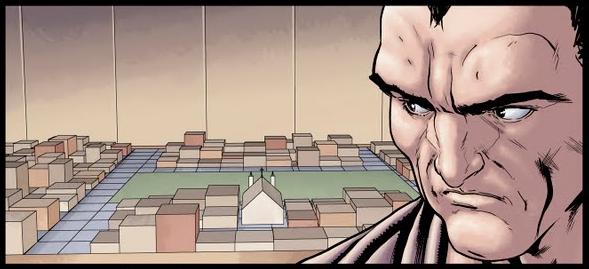 DQ: We came back with a pretty fully developed story and they made us partners in the property and allowed us to really explore the furthest extent of our basic, "medicine vs. evil" idea. Fantasy Prone assembled a great team around us on this book, and supported us and David when we needed it. We're not dumb enough to think that all comics are made like this. Archaia deserves a lot of credit for how they run their business -- it's totally cued toward putting out these nice, Class-A hardcover volumes. Even their Free Comic Book Day book this year looked like something that should cost six bucks. I hope they're in the marketplace for a good, long time.
DQ: We came back with a pretty fully developed story and they made us partners in the property and allowed us to really explore the furthest extent of our basic, "medicine vs. evil" idea. Fantasy Prone assembled a great team around us on this book, and supported us and David when we needed it. We're not dumb enough to think that all comics are made like this. Archaia deserves a lot of credit for how they run their business -- it's totally cued toward putting out these nice, Class-A hardcover volumes. Even their Free Comic Book Day book this year looked like something that should cost six bucks. I hope they're in the marketplace for a good, long time.RJR: On the art side, I saw David's work via his website -- specifically, I saw a Batman sketch that I LOVED. What I really loved about it was how David let the great, simple design of Batman do all the work and he wasn't completely obsessed with making Batman's muscles bulge in that fake, lame steroidal way. He just let the core ideas and lines shine through.
DQ: David was our first choice to draw this and it's impossible to imagine anyone else "getting" it the way he did. He is the thing everyone is talking about when they talk about this book.
RJR: The book was offered to David I think in June 2009 and then at Comic Con last year we spent Sunday with him just going through what the project was going to be and soliciting his ideas on what he wanted to draw. At that point there was a 13-page, highly detailed outline of the book, and David left San Diego with the mandate to take two months to develop the visuals of the book's world with us. He is an impeccable, detail-oriented storyteller and kind of the only reason this weird book is seeing the light of day. Confident, clean and lines over some really interesting compositions that you just don't see everyday in comics.
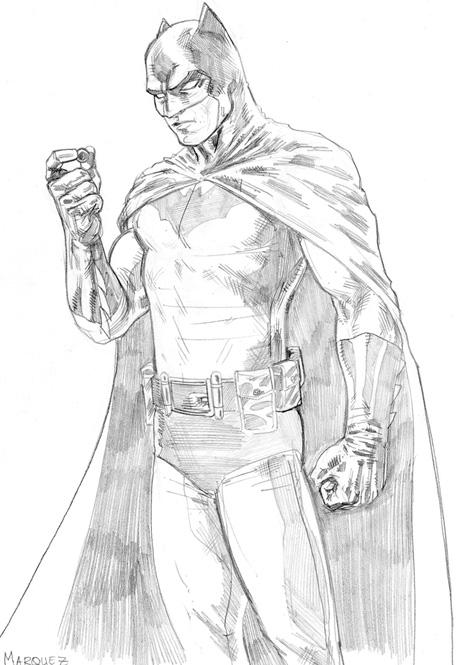
BUG: This is a one shot original graphic novel. Was this the format you were going for from the beginning or was it ever going to be a miniseries?
RJR: Always. It was a huge reason we got involved. The idea of working on something over the course of a year and really honing it as a "whole" instead of grinding out individual chapters was amazing. That's only possible because of Archaia's business model, where they run more like a hardcover book publishing house than a classical "comics publisher," as an outgrowth of the magazine and newspaper industries. You will never find an Archaia book at a newsstand or Rite Aid. MOUSE GUARD is one of the most successful graphic novels of all time in part because of that model. Stephen Christy, our editor on this book who is also now Editor-In-Chief at Archaia, is incredibly passionate about the format of the standalone, evergreen graphic novel. Just talk to him and you'll see!DQ: We wrote the story to be read in one standalone graphic novel and to be completely self-contained. That said, we did set it up so that if the book is successful the story could continue on.
BUG: What influenced you guys to come up with this concept? There's a heavy interest in psychology in this story and often that's not a subject delved into so deeply in comics.

DQ: Josh and I are both very interested in psychology and how the physiology of the brain effects behavior and even creates personality. We’re at a time in history when there is a tremendous amount of research and discovery that we decided to use as a jumping-off point. The fact is, the issues we address in this book will likely be real moral questions in the years ahead.
BUG: What type of research went into coming up with this story? It seems very accurate in its use of psychology, criminology, and the mind of sociopaths.
RJR: There was endless and intimidating research that could have gone even deeper than it did but didn't because of our deadlines. But it was like taking a graduate course in this stuff. When you look at it, dictionary-definition "sociopathy" turns out to be impossible to treat, simply by definition. And the truth is that there has never been a double blind clinical trial or piece of solid medical research whose subjects were dictionary-definition sociopaths, psychopaths, or "psychotic killers." There have of course been papers and essays comparing cases, but no study, at least no study published, anyway.DQ: There is a very good reason for this, too, and one that kind of suggested the entire conceit of this book. That is, in order to use the process of psychiatry to treat a sociopath, the patient would need to engage in the process, but, by nature, they are disinclined to do so. In fact, they see nothing wrong that would need to be cured in the first place.
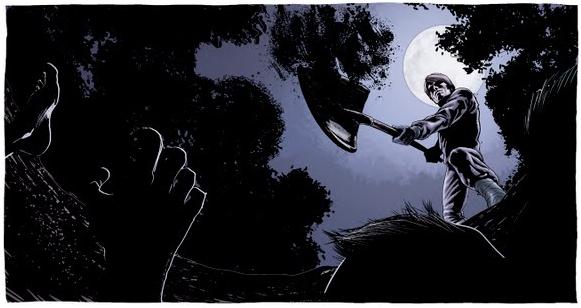
BUG: The doctor behind this project is a therapist who failed at his job and turned to more of a science/neurological field of study in the process. Was this aspect of the character derived from real life? It seems like a very real frustration therapists may have.
RJR: Alois Alzheimer was a psychiatrist who moved sharply toward neuropathology in the later stages of his career, and in the past we've mentioned he was one inspiration. But also during development we talked a lot about Edwin Hubble, the famed astronomer, and how he fell into astronomy relatively late in his academic career. He was a Rhodes Scholar, but for Spanish! What pushes someone to change tracks like that? Hubble also had some interesting eccentricities -- like a kind of condescending, imperious attitude that his colleagues joked about behind his back -- that were food for thought when coming up with the characterization of a driven scientist that you see in our book.DQ: The scientific mind can also be a very arrogant one if you think about it. The scientist not only believes that all things can be understood and categorized, but that they will be the ones to discover and illuminate the truth for all others.
BUG: Can you explain how you guys (writers and artist) collaborated on this project? Did the art part come in later or was it a collaboration from the beginning?
DM: The creation of SYNDROME was a team effort. I was brought on board as the script was being written and was invited to play an active role as it developed. When a draft was completed, the writers and editors encouraged me to provide my input and I was happy to do so. Likewise, the writers were very heavily involved in the art side of production. The internet, in particular, really helped this process. Throughout the project we made very heavy use of Google Wave - basically an online collaborative document editor. For each chapter of the book, we'd hash out things like mood and theme ("this is the "Michael Mann" or "David Lynch" chapter, for instance) and toss together a bunch of reference materials. From there, I would do my roughs and submit each page to the Wave for the writer's feedback. I work in an all-digital workflow which, in addition to allowing me some fun computer trickery, facilitates really quick revisions and edits. While not quite the same as a true "bullpen" workplace, Google Wave made collaboration an extremely easy and nearly instantaneous despite the thousand miles of meatspace separating the various members of the team. RJR: Plug over -- but yes it's an ideal tool for making comics. Everybody should try it!
RJR: Plug over -- but yes it's an ideal tool for making comics. Everybody should try it!BUG: Without giving away too much about the ending, would you ever think of revisiting this story for a sequel? It seems ripe for one.
DM: Absolutely. We've all kept busy since SYNDROME wrapped, but if there's an audience for a SYNDROME 2, we'll make it happen.RJR: Even though the book has a firm, clear ending, nothing is preventing more stories from being told in this world. But I could also rest easy knowing this was the only SYNDROME, ever. Of course there's more to the story, but that's only going to happen if the marketplace demands it, and it would take about a year to do. The book right now is meant to be a full meal, a complete thing. And David has a lot of work on his dance card right now for some big companies. We lucked out in getting him when we did.
BUG: Having read the story, it very much feels like a movie in the making, maybe because of the TRUMAN SHOW aspects. Did you see this story as a movie first or was it always to be a comic book?
RJR: The greatest thing ever would be for someone to make this into a movie in like twenty or thirty years. I don't think right now our careers could withstand a horrible movie being made out of this book, and there's always a strong chance of that. We have really been focused on the comic book and making it, on its own terms, as cinematic and individualistic as possible.DQ: We deliberately did not think about how it would translate to other media because, for one thing, we love comics, but also, we felt that if it wasn’t a great comic first, then none of the other stuff would matter.
BUG: What's it been like working with Archaia? How much freedom have you had with your story?
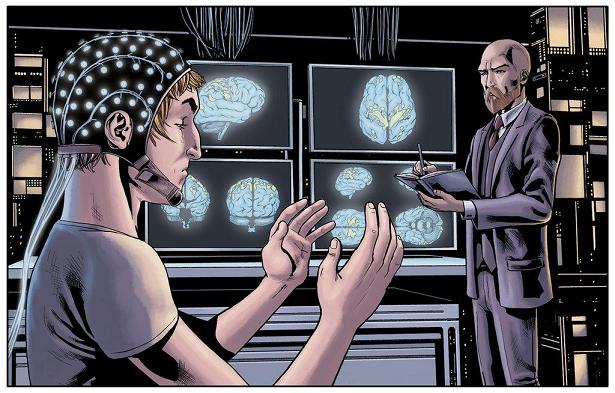 RJR: Total freedom and complete support from both Archaia and Fantasy Prone. What they do is development in the best sense -- which is making you talk out all of your ideas and pitch their merits. With the case of this book, we were allowed to tackle some pretty challenging and even upsetting material, and not really have any content restrictions.
RJR: Total freedom and complete support from both Archaia and Fantasy Prone. What they do is development in the best sense -- which is making you talk out all of your ideas and pitch their merits. With the case of this book, we were allowed to tackle some pretty challenging and even upsetting material, and not really have any content restrictions.DQ: I can’t think of a single thing that Archaia did that didn’t improve this book. They were outstanding collaborators. And Fantasy Prone gave us nothing but support and encouragement the entire way.
BUG: Speaking of C2E2, what was your C2E2 Con experience like this year?
RJR: C2E2 was super interesting, because it was a real comics show, not a mini San Diego TV/toy/random studio movie/Warcraft mash-up thing. It was focused. I feel like I saw nothing but comics fans and comics people and comics artists the entire weekend. It was very cued to the professional community, which was different. At times it felt like there were more pros and press than actual fans, which is not a bad thing once in a while.BUG: Last chance, why should everyone pick up SYNDROME when it's released and when can they find it in stores?
 RJR: First of all, if you are coming to San Diego you can pick it up straight from Archaia there -- and visit with us in the process. They have been nice enough to give the book a launch platform at SDCC a few weeks before the August release. It's on Amazon now, and bookstores in the very early fall. The cover price is $20 and if that's an issue, there are places online if you know where to look where it's the same price as a movie ticket. And I am sure it will be bootlegged at some point too, so there's that. But the main reason to buy it is it's a very nice package and it's David's first full-length work. Archaia has a reputation for just nailing the hardcover format, and hopefully this book is no exception. Humbly, the story isn't something that's been done in comics before.
RJR: First of all, if you are coming to San Diego you can pick it up straight from Archaia there -- and visit with us in the process. They have been nice enough to give the book a launch platform at SDCC a few weeks before the August release. It's on Amazon now, and bookstores in the very early fall. The cover price is $20 and if that's an issue, there are places online if you know where to look where it's the same price as a movie ticket. And I am sure it will be bootlegged at some point too, so there's that. But the main reason to buy it is it's a very nice package and it's David's first full-length work. Archaia has a reputation for just nailing the hardcover format, and hopefully this book is no exception. Humbly, the story isn't something that's been done in comics before.DQ: People should pick up the book if they want to support comic storytelling that tries to do something adult and different. There are a lot of people out there who think that comic book fans only want superheroes, monsters, aliens or zombies, and we think that’s nonsense. We think this is just as valid and exciting a medium as any other, but the only way to prove this is if the sales are there to support more of it.
BUG: Thanks guys for doing this interview with me twice. Much appreciated and it’s definitely a book worth covering. Those lucky enough to pick the book up at the Archaia booth at SDCC this year know exactly what I mean. Check out SYNDROME from Archaia when it hits the coolest of comic shops in the fall. Now, I’m off to the con again.
Ambush Bug is Mark L. Miller, original @$$Hole / wordslinger / reviewer / co-editor of AICN Comics for over nine years. Check out his ComicSpace page for his entries in Cream City Comics’ MUSCLES & FIGHTS VOL.3 and MUSCLES & FRIGHTS VOL.1 anthologies. Bug was interviewed here & here (about AICN Comics) and here & here (on his VINCENT PRICE PRESENTS: THE TINGLER comics). Bug’s latest comic is VINCENT PRICE PRESENTS #21: WITCHFINDER GENERAL (available in May’s Previews Order # MAY100828) on sale in July. Fanboy Radio recently interviewed Bug about it here. Bug was also interviewed here & here about his upcoming original vampire miniseries NANNY & HANK (available in June's Previews Order #JUN100824) due out in August.